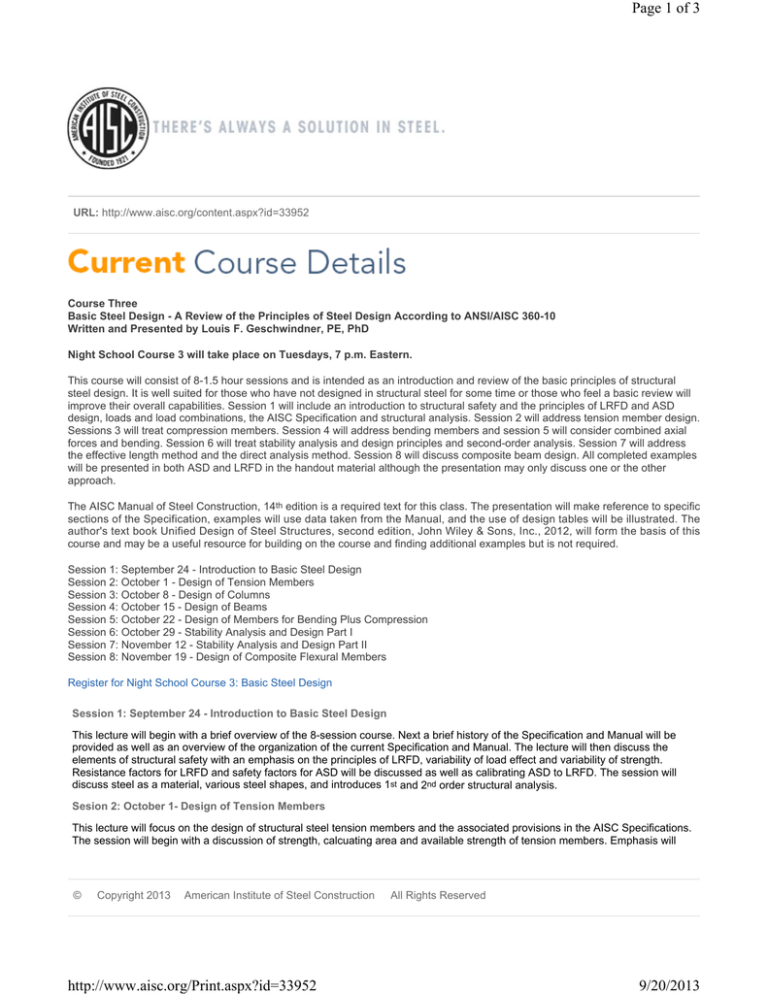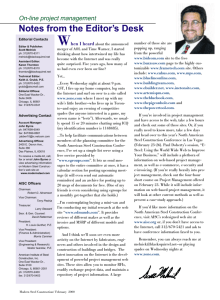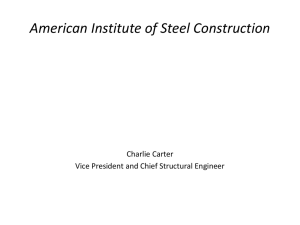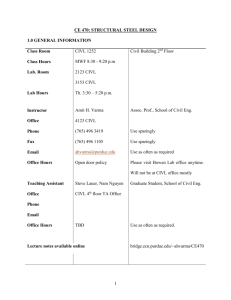
Page 1 of 3
URL: http://www.aisc.org/content.aspx?id=33952
Course Three
Basic Steel Design - A Review of the Principles of Steel Design According to ANSI/AISC 360-10
Written and Presented by Louis F. Geschwindner, PE, PhD
Night School Course 3 will take place on Tuesdays, 7 p.m. Eastern.
This course will consist of 8-1.5 hour sessions and is intended as an introduction and review of the basic principles of structural
steel design. It is well suited for those who have not designed in structural steel for some time or those who feel a basic review will
improve their overall capabilities. Session 1 will include an introduction to structural safety and the principles of LRFD and ASD
design, loads and load combinations, the AISC Specification and structural analysis. Session 2 will address tension member design.
Sessions 3 will treat compression members. Session 4 will address bending members and session 5 will consider combined axial
forces and bending. Session 6 will treat stability analysis and design principles and second-order analysis. Session 7 will address
the effective length method and the direct analysis method. Session 8 will discuss composite beam design. All completed examples
will be presented in both ASD and LRFD in the handout material although the presentation may only discuss one or the other
approach.
The AISC Manual of Steel Construction, 14th edition is a required text for this class. The presentation will make reference to specific
sections of the Specification, examples will use data taken from the Manual, and the use of design tables will be illustrated. The
author's text book Unified Design of Steel Structures, second edition, John Wiley & Sons, Inc., 2012, will form the basis of this
course and may be a useful resource for building on the course and finding additional examples but is not required.
Session 1: September 24 - Introduction to Basic Steel Design
Session 2: October 1 - Design of Tension Members
Session 3: October 8 - Design of Columns
Session 4: October 15 - Design of Beams
Session 5: October 22 - Design of Members for Bending Plus Compression
Session 6: October 29 - Stability Analysis and Design Part I
Session 7: November 12 - Stability Analysis and Design Part II
Session 8: November 19 - Design of Composite Flexural Members
Register for Night School Course 3: Basic Steel Design
Session 1: September 24 - Introduction to Basic Steel Design
This lecture will begin with a brief overview of the 8-session course. Next a brief history of the Specification and Manual will be
provided as well as an overview of the organization of the current Specification and Manual. The lecture will then discuss the
elements of structural safety with an emphasis on the principles of LRFD, variability of load effect and variability of strength.
Resistance factors for LRFD and safety factors for ASD will be discussed as well as calibrating ASD to LRFD. The session will
discuss steel as a material, various steel shapes, and introduces 1st and 2nd order structural analysis.
Sesion 2: October 1- Design of Tension Members
This lecture will focus on the design of structural steel tension members and the associated provisions in the AISC Specifications.
The session will begin with a discussion of strength, calcuating area and available strength of tension members. Emphasis will
©
Copyright 2013
American Institute of Steel Construction
http://www.aisc.org/Print.aspx?id=33952
All Rights Reserved
9/20/2013
Page 2 of 3
then be placed on designing tension members before discussing the concept of block shear. The session concludes with an
overview of eyebars, pin connected members, truss members and braces. Several design examples will be presented.
Session 3: October 8- Design of Compression Members
The design of columns – compression members, is the focus of this session. The session will review the strength of compression
members as defined by the Specification. The session will review steel shapes and their behavior in compression. The session
will discuss the limit states of flexural buckling, local buckling, torsional buckling, and flexural-torsional buckling. Members with
and without slender elements are reviewed. Design examples will be presented.
Session 4: October 15- Design of Flexural Members
This session will discuss the design of structural steel beams and application of Chapter F of the AISC Specification. The session
will review plastic vs. elastic moment strength and the various limit states of bending members. The lecture will address Cb, the
lateral-torsional buckling modification factor for non-uniform moments diagrams and its effect on beam designs. The session will
also review the design of single angles and WT shapes. Design examples will be presented.
Session 5: October 22 - Design of Members for Bending Plus Compression
This lecture will discuss the behavior and design of beam-columns. The session will review elastic and plastic interaction
principles, AISC interaction equations and design rules of thumb. The session will explore the design of members in single axis
bending as well as the design of single angles for bending plus compression.
Session 6: October 29- Stability Analysis and Design, Part I
Part I of this 2-session lecture on Stability Analysis and Design will review the five stability requirements to be considered in
design. The session will review required strength and available strength. The session will then discuss 2nd order analysis and
demonstrate how methods to calculate 2nd order effects by hand. This will include presenting the development of the B1-B2
method discussed in the AISC Specification, Appendix 8 – Approximate Second-Order Analysis.
Session 7: November 12- Stability Analysis and Design, Part II
Part II of this 2-session lecture continues to explore the requirements of the AISC Specification for the design for stability. The
session will discuss and demonstrate the Effective Length Method through examples. The session will then highlight the Direct
Analysis Method and discuss the advantages of the method; specifically, that the Direct Analysis Method allows the of a K-factor
equal to 1.
Session 8: November 19- Design of Composite Flexural Members
This session examines the principles of composite action. The lecture will review elastic vs. plastic behavior and the influence of
steel deck on composite members. The session will discuss the design of composite beams including determining steel-headed
stud anchor strength and placement, deflection, and economy in shape selection. The session will conclude with a review of the
encased and filled composite members.
Lecturers
Louis F. Geschwindner, PE, PhD
Louis F. Geschwindner is a former Vice President of Engineering and Research at AISC and Professor
Emeritus of Architectural Engineering at Penn State University. He received his Bachelor's degree in
building science from Rensselaer Polytechnic Institute and both his Master of Science in architectural
engineering and his Ph.D. in civil engineering from Penn State. He is a Registered Professional Engineer
and taught at Penn State for more than 40 years. Professor Geschwindner is a past chairman of the
Committee on Design of Steel Building Structures of the Structural Engineering Institute of the American
Society of Civil Engineers (SEI/ASCE) and is a member of the AISC Committee on Specifications.
Chairing its Member Design technical committee. Dr. Geschwindner has been an author and presenter in
many of the American Institute of Steel Construction lecture series.
Attendance, Quizzes and Recordings
Recording and quiz access is available only for those who registered for the 8-session package.
Recordings: As part of your registration for the 8-session package, you are provided access to the recording of each session. After
each session, you will be sent an email that includes a link to the recording. Access to the recording will be available for two weeks
following the session.
Quizzes: IMPORTANT: As part of your registration for the 8-session package, you are provided access to a quiz on each session.
After each session, you will be sent an email that includes a link to the quiz. Take the quiz and submit by the due date given. Note:
©
Copyright 2013
American Institute of Steel Construction
http://www.aisc.org/Print.aspx?id=33952
All Rights Reserved
9/20/2013
Page 3 of 3
if you attend the live session, you do not have to take the quiz to receive PDHs/CEUs. Quiz scores will be posted and access can
be found in the table below. The quiz score table will state a passing grade for the CEUs/PDHs. Registrants are identified by their
Web ID (found on your original receipt), first three letters of your last name and first initial. If you would like to re-take the quiz, you
will be given the opportunity. Final scores will be posted and answers will be provided on the date noted below.
Why take the quiz?
If you watch a recorded session and want to receive CEUs/PDHs for that session, you must take AND PASS the quiz.
However, if you watch a live session, you do not need to take and pass the quiz in order to receive CEUs/PDHs.
If you want to earn the EEU (1 Equivalent Education Unit - approximately equal to 1 semester hour) credit you must take and
pass all quizzes and the final exam.
The quiz serves to reinforce what was taught during the session. Regardless of your interest in the course credits, in order to get
the most out of the course, you are highly encouraged to participate in the quizzes.
©
Copyright 2013
American Institute of Steel Construction
http://www.aisc.org/Print.aspx?id=33952
All Rights Reserved
9/20/2013






